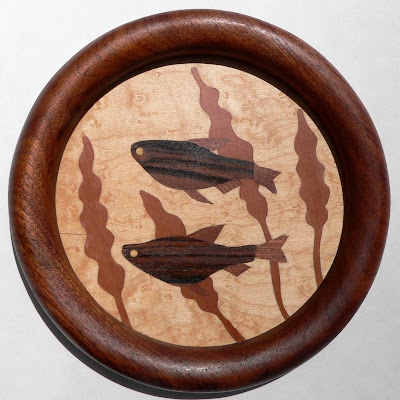Here's a fairly simple original ghost amigurumi pattern to make for Halloween. The ghost is made from worsted weight yarn and is about 4inches tall. The arms are a little tricky since they have multiple increases and decreases. If you prefer, a pdf of the pattern is available on Ravely
here.
Supplies:
size F crochet hook
small amount white worsted weight yarn
scrap amount black DMC perle cotton size 5 for features
polyester fiberfill stuffing
3” square or circle plastic canvas
yarn needle
Abbreviations
Rnd: round
ch: chain
st: stitch
sc: single crochet
sl st: slip stitch
sc dec: single crochet decrease (sometimes denoted as sc2tog). Insert hook in next sc. Bring up a loop. Insert hook in next sc. Bring up another loop. Yarn over hook and bring through all loops on hook. Alternately, substitute an invisible decrease (invdec) if desired.
Numbers enclosed in parentheses indicate the number of stitches at the end of the round or row.
Directions enclosed in * * indicate instructions which are to be worked the specified number of times.
Note: This pattern is worked in a continuous spiral. Please mark the end of each round with a paper clip or contrasting colored thread. Do not join each round with a slip stitch.
Head and Body, Starting at Head:
using white yarn
Rnd 1: ch 2, work 6 sc in second ch from hook (6 sc)
Alternately, substitute a magic ring with 6 sc.
Rnd 2: starting in the 1st sc of Rnd 1, *2 sc in next st* 6 times (12 sc)
Rnd 3: sc in each st around (12 sc)
Rnd 4: *2 sc in next st, sc in next st* 6 times (18 sc)
Rnd 5: *sc in next 2 st, 2 sc in next st* 6 times (24 sc)
Rnd 6 - 9: sc in each st around (24 sc)
Rnd 10: *sc dec, sc in next 2 st* 6 times (18 sc)
Rnd 11: sc in each st around (18 sc)
Rnd 12: *sc in next st, sc dec* 6 times (12 sc)
Rnd 13: *2 sc in next st, sc in next st* 6 times (18 sc)
Rnd 14: *sc in next 2 st, 2 sc in next st* 6 times (24 sc)
Rnd 15: *2 sc in next st, sc in next 7 st* 3 times (27 sc)
Rnd 16: sc in each st around (27 sc)
Rnd 17: sc in next 4 st, *2 sc in next st, sc in next 8 st* 2 times, 2 sc in next st, sc in next 4 st (30 sc)
Rnd 18-19: sc in each st around (30 sc)
Rnd 20: sc in next 7 st, *2 sc in next st, sc in next 9 st* 2 times, 2 sc in next st, sc in next 2 st (33 sc)
Rnd 21-22: sc in each st around (33 sc)
Rnd 23: *2 sc in next st, sc in next 10 st* 3 times (36 sc)
Rnd 24-25: sc in each st around (36 sc)
Rnd 26: sc in next 5 st, *2 sc in next st, sc in next 11 st* 2 times, 2 sc in next st, sc in next 6 st (39 sc)
Rnd 27-28: sc in each st around (39 sc)
Fasten off.
Base:
using white yarn
Rnd 1: ch 2, work 6 sc in second ch from hook (6 sc)
Alternately, substitute a magic ring with 6 sc.
Rnd 2: starting in the 1st sc of Rnd 1, *2 sc in next st* 6 times (12 sc)
Rnd 3: *2 sc in next st, sc in next st* 6 times (18 sc)
Rnd 4: *sc in next 2 st, 2 sc in next st* 6 times (24 sc)
Rnd 5: *2 sc in next st, sc in next 3 st* 6 times (30 sc)
Rnd 6: sc in next 3 st, *2 sc in next st, sc in next 4 st* 5 times, 2 sc in next st, sc in next st (36 sc)
Rnd 7: *2 sc in next st, sc in next 11 st* 3 times (39 sc)
Fasten off leaving enough yarn to sew base onto body. Cut a circle out of the plastic canvas slightly smaller than the base. Stuff head and body. Place plastic canvas circle on wrong side of base. Sew base onto body with plastic canvas and wrong side on the inside of ghost.
Arms (make 2):
using white yarn
Rnd 1: ch 2, work 4 sc in second ch from hook (4 sc)
Alternately, substitute a magic ring with 4 sc.
Rnd 2: sc in each st around (4 sc)
Rnd 3: *2 sc in next st, sc in next st* 2 times (6 sc)
Rnd 4: sc in each st around (6 sc)
Rnd 5: 2 sc in each of next 2 st, sc in next 4 st (8 sc)
Rnd 6: sc in next st, 2 sc in each of next 2 st, sc in next st, 2 sc dec (8 sc)
Rnd 7: sc in next 2 st, 2 sc in next st, sc in next 3 st, sc dec (8 sc)
Rnd 8: sc in next 4 st, 2 sc in next st, sc in next 3 st (9 sc)
Rnd 9: sc in next 4 st, 2 sc in next st, sc in next 4 st (10 sc)
Rnd 10: 2 sc in each of next 2 st, sc in next 2 st, 2 sc dec, sc in next 2 st (10 sc)
Rnd 11: sc in next st, 2 sc in next st, sc in next 3 st, sc dec, sc in next 3 st (10 sc)
Fasten off leaving enough yarn to sew arm onto body. Stuff arms. Refer to photo to place and shape arms.
Embroider features as desired.
Like this pattern? Make sure to follow this blog or like my
Facebook fan page to be the first to find out when new patterns are available.







































